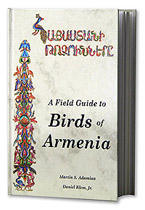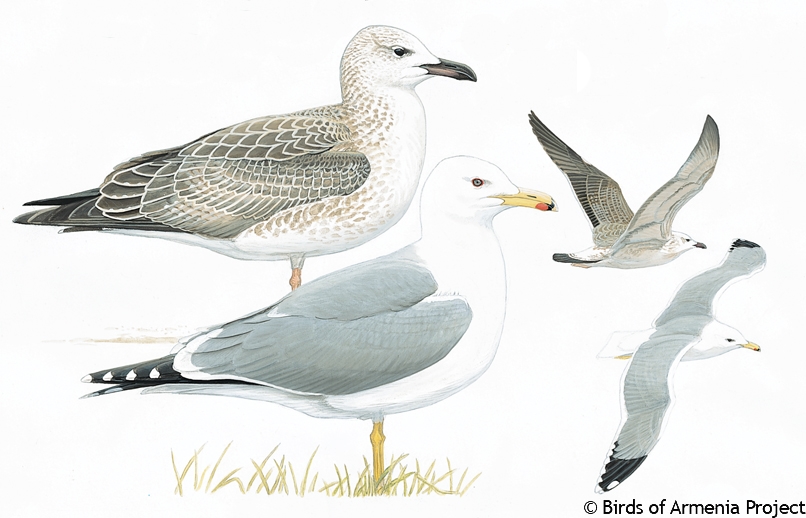- Pictures of All Birds
- Find Bird by Common Name
- Find Bird by Scientific Name
- Find Bird by Armenian Name
- Orders of Birds
- Distribution Maps
- Location of Armenia
- Species of Special Concern

Purchase the Field Guide
© Copyright Birds
of Armenia Project

| Armenian Name: | Հայկական որոր |
|---|---|
| Species Status: | Threatened Species - Species of Special Concern |

See Plate 32 for Armenian Gull and other similar species
| Resident Status: | Year-round resident |
|---|---|
| Abundance: | Common |
| Length: | 55-60 cm, Wing Span:131-143 cm |
| Distribution Map: | Map 155. |
| Description: | Dark eyes, yellow legs, and dark-banded bill. |
| Adult: | In flight, shows extensive black area on outerwing with one white patch on outermost primary. About 90% of birds have a dark iris (brown to yellowish-gray). |
| Adult (Breeding): | White head, underparts and tail; light gray upperparts. Legs bright orange-yellow. Bill yellow with obvious red spot near tip of lower mandible and, on about 10% of birds, a narrow black subterminal band. |
| Adult (Non-breeding): | Bill has pale yellow tip with a well-defined black subterminal band obscuring red spot. Legs duller. |
| Juvenile: | Dark bill; pinkish legs. Whitish head, neck, and body with finely-streaked crown and denser brown spots and streaks on nape and hindneck. Mantle and scapulars brown-gray. Outer primaries and secondaries blackish-brown contrasting with lighter upperwing coverts; usually shows a paler area on inner primaries. Clear dark underwing bar on secondaries. |
| First Winter: | Upperparts similar to juvenile but underparts are whiter and less-streaked. |
| Similar Species: | Differs from Yellow-legged Gull by usually showing a dark iris and black bill band. |
| Behavior: | Gregarious. Often in fields and near refuse areas. |
| Habitat: | Widespread near water. |
| Food: | Wide variety of animals and plants. |
| Nest: | Scrape among stones or grass, often under cover of shrubs. |
| Eggs: | 70 mm, 3, greenish-brown, brown spots. |